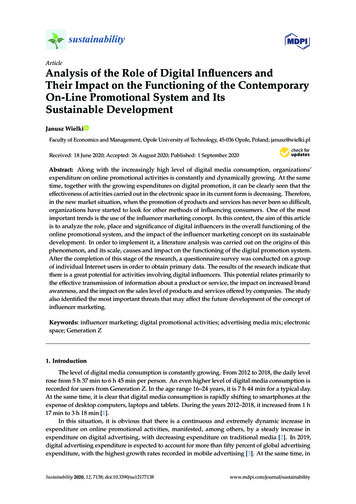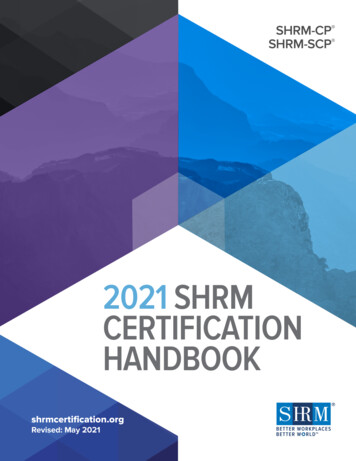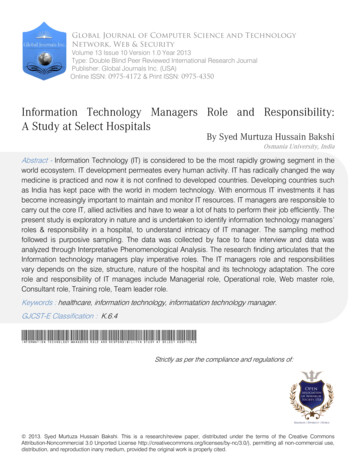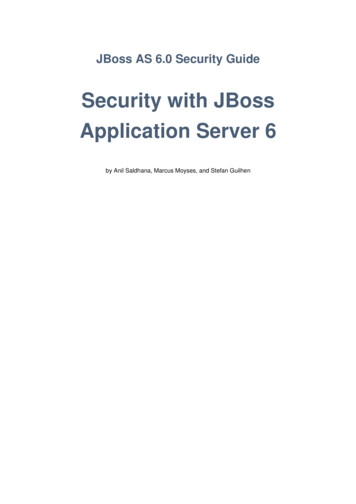
Transcription
sustainabilityArticleAnalysis of the Role of Digital Influencers andTheir Impact on the Functioning of the ContemporaryOn-Line Promotional System and ItsSustainable DevelopmentJanusz WielkiFaculty of Economics and Management, Opole University of Technology, 45-036 Opole, Poland; janusz@wielki.plReceived: 18 June 2020; Accepted: 26 August 2020; Published: 1 September 2020 Abstract: Along with the increasingly high level of digital media consumption, organizations’expenditure on online promotional activities is constantly and dynamically growing. At the sametime, together with the growing expenditures on digital promotion, it can be clearly seen that theeffectiveness of activities carried out in the electronic space in its current form is decreasing. Therefore,in the new market situation, when the promotion of products and services has never been so difficult,organizations have started to look for other methods of influencing consumers. One of the mostimportant trends is the use of the influencer marketing concept. In this context, the aim of this articleis to analyze the role, place and significance of digital influencers in the overall functioning of theonline promotional system, and the impact of the influencer marketing concept on its sustainabledevelopment. In order to implement it, a literature analysis was carried out on the origins of thisphenomenon, and its scale, causes and impact on the functioning of the digital promotion system.After the completion of this stage of the research, a questionnaire survey was conducted on a groupof individual Internet users in order to obtain primary data. The results of the research indicate thatthere is a great potential for activities involving digital influencers. This potential relates primarily tothe effective transmission of information about a product or service, the impact on increased brandawareness, and the impact on the sales level of products and services offered by companies. The studyalso identified the most important threats that may affect the future development of the concept ofinfluencer marketing.Keywords: influencer marketing; digital promotional activities; advertising media mix; electronicspace; Generation Z1. IntroductionThe level of digital media consumption is constantly growing. From 2012 to 2018, the daily levelrose from 5 h 37 min to 6 h 45 min per person. An even higher level of digital media consumption isrecorded for users from Generation Z. In the age range 16–24 years, it is 7 h 44 min for a typical day.At the same time, it is clear that digital media consumption is rapidly shifting to smartphones at theexpense of desktop computers, laptops and tablets. During the years 2012–2018, it increased from 1 h17 min to 3 h 18 min [1].In this situation, it is obvious that there is a continuous and extremely dynamic increase inexpenditure on online promotional activities, manifested, among others, by a steady increase inexpenditure on digital advertising, with decreasing expenditure on traditional media [2]. In 2019,digital advertising expenditure is expected to account for more than fifty percent of global advertisingexpenditure, with the highest growth rates recorded in mobile advertising [3]. At the same time, inSustainability 2020, 12, 7138; ability
Sustainability 2020, 12, 71382 of 20countries such as the United Kingdom, China, Norway and Canada, digital has already become thedominant ad medium [4].With increasing investments, what is clearly visible is the decreasing effectiveness of activitiescarried out in the electronic space [5,6]. There are a number of reasons for this situation. Undoubtedly,the fact that consumers are becoming a more and more complex group is an extremely importantissue [7,8]. In this context, their susceptibility to the marketing activities applied to date is clearly visible;e.g., according to Harris Interactive, 90% of Americans ignore digital advertising [9]. This situationresults from dissatisfaction with the ways the organizations use to communicate with them. In recentyears, this has been clearly manifested by the development of the ad-blocking phenomenon [10,11].Its main reasons are too many advertisements being displayed online, and their growing aggressivenessaffecting the on-line user experience [6,12,13]. Another important factor is that users become aware of thehidden costs resulting from online ads, such as increased loading time and bandwidth consumption [14].As a result, the development of ad-blocking leads to the collapse of one of the key online businessmodels according to which advertisers pay publishers a certain amount of money for each display oftheir advertisement to a visitor on their Website. In this situation, many organizations are trying toimprove the on-line user experience by using personalized marketing [15]. However, more and moreresearch shows that this experience does not need to be improved by such an approach [16]. There aremany different reasons for that. For example, some of those who block ads use ad-block solutions tocurb on-line tracking, which hinders the data collection needed for personalized marketing [17]. As,in recent years, environmental issues became vital aspects for growing number of consumers, suchconcepts as green advertising [18] and environmental advertising [19] have become important trendsin the case of promotional activities.An important element in the evolving market is the growing presence of Generation Z, which is agrowing group of consumers; e.g., in the US, they will account for 40% of all consumers by 2020 [14]. This isa generation that does not know reality without the Internet, for whom the world made up of technologyand geographical constraints does not exist [15]; therefore, it is also referred to as “the first generation of truedigital natives” [16]. It behaves completely differently, and completely different problems are important forthem, compared to the previous generation of consumers; i.e., millennial cohorts [15]. Its representativesvalue individual expression and avoid labels. They can also be easily mobilized for various purposes(reasons). They make decisions in a highly analytical and pragmatic way. At the same time, asconsumers, they are mostly well-educated as far as brands and their realities are concerned [20–23].They are also environmentally conscious, caring about sustainable consumption [24].This generation requires a completely different marketing approach from the organization, since,among other things, it is ceasing to pay attention to many of the advertising forms used so far. Spendinga lot of time in social media [1,25], they willingly follow the persons present in it who they trust [26].Therefore, in the new market situation, when promoting products, services or brands has never beenso difficult, organizations have begun to look for alternative methods of influencing consumers [27].One of the most important trends is the use of the concept of influencer marketing [28–30]. This conceptis understood as “marketing practice that takes advantage of well-followed online users, who are ableto influence consumers’ attitudes and decision-making processes in favor of brands or ideas” [31].The concept belongs to one of three main types of online media channels: earned media (the othertwo are paid media and owned media) [32]. Influencer marketing has become the fastest growingtrend in terms of communication with customers, and the number of its campaigns and posts hasgrown exponentially year-over-year from 2015 onwards [33,34]. This changes the functioning of entireindustries [35,36], being a critical element for success in many of them [37]. As shown by studiescompleted by McKinsey & Company in India, the power of digital influencers can be truly significant.According to their results, 80% of consumers will consider a new brand based on the recommendationof a key influencer [38]. At the same time, in many cases, they are becoming a new type of a localpartner, referred to as a local digital influencer, without the participation of whom it is difficult toimagine companies’ expansion into new foreign markets [39]. Meanwhile, the differences in the
Sustainability 2020, 12, x FOR PEER REVIEWSustainability 2020, 12, 71383 of 213 of 20compared to other groups are clearly visible [40]. According to the Harvard Business Review, 19% ofAmericanconsumersboughtgoods orin 2018as a resultcomparedof the recommendationsa digitalimpact exertedby digitalinfluencersonservicesGenerationZ consumersto other groupsofareclearlyinfluencer.the grouptoofconsumerswho areReview,below 25,thiswas almosttwice goodsas high;visible [40].InAccordingtheHarvard Business19%of percentageAmerican consumersboughtori.e.,itamountedto36%[41].services in 2018 as a result of the recommendations of a digital influencer. In the group of consumersgrowingof digitalinfluencersconfirmedby organizationsincreasing thewho Theare below25,significancethis percentagewas almosttwiceisasalsohigh;i.e., it amountedto 36% [41].expenditureallocatedto this formof marketingactivities.As shown by organizationsvarious studies,the scaletheofThe growingsignificanceof digitalinfluencersis also confirmedincreasinguseof influencersin thetomarketingof organizationsconstantlygrowing.Accordingto theexpenditureallocatedthis form activitiesof marketingactivities. Asisshownby variousstudies,the scaleofInfluencerMarketingBenchmark2020,the value of isinfluencermarketingan industryisuse of influencersin themarketingReport:activitiesof organizationsconstantlygrowing. asAccordingto 6.5billionin2019,andUSD9.7billioninInfluencer Marketing Benchmark Report: 2020, the value of influencer marketing as an industry is2020[42].toThedata fromfrom USDthe edincrease1.7 billionin 2016byto USD6.5 billionin Intelligence2019, and USDbillioninoptimistic.Accordingto thethem,the preparedvalue of theinfluencerInsidermarketingindustryamountto USD 82020 [42]. Thedata fromreportby BusinessIntelligencearewillevenmore optimistic.billionin 2019,and willreach USDbillion in marketing2022 [43]. Thegrowingof theindustrycan beAccordingto them,the valueof the15influencerindustrywillvalueamountto USD8 billioninseen,the numberinfluencerfocusedIt2019, forandexample,will reachinUSD15 billionofinnew2022platforms[43]. The andgrowingvalue marketingof the industrycan agencies.be seen, forincreasedfromto 1120between2015 andand bymarketingas much as380 between2018and 2019example, inthe190numberof newplatformsand2019,influencerfocusedagencies.It increased[42].from 190 to 1120 between 2015 and 2019, and by as much as 380 between 2018 and 2019 [42].In the context of the above-presentedabove-presented marketmarket trends,trends, thethe aimaim ofof thisthis articlearticle isis toto analyzeanalyze thethe role,role,place gital influencers in the overall functioning of the on-line promotional system,system,the ofimpactof the conceptof influencermarketingon its sustainabledevelopment.In thisand the andimpactthe conceptof influencermarketingon its sustainabledevelopment.In this regard,regard,sustainabledevelopmentis understoodas such developmentof thisthatsystemthat inutilizes,insustainabledevelopmentis understoodas such developmentof this systemutilizes,the uture—meansofdigitalpromotioninorderbalanced way, all available—now and in the future—means of digital promotion in order to achievetoachieveresultsoptimumresultsin theprocess ofcommunicationmarketing communicationwithcustomers,taking intooptimumin theprocessof marketingwith customers,takinginto considerationconsiderationCSRissues.CSR issues.The primary researchresearch gingGenerationtotoGenerationZ;Z;groupof consumersfor whomthis offormof marketingis particularlyimportant.i.e.,i.e.,thethegroupof consumersfor whomthis formmarketingactivityactivityis particularlyimportant.The aimThewasfill the researchexisting researchgap concerningthe real significancedigital influencerswas aimto fillthetoexistinggap concerningthe real significanceof digitalofinfluencersand theandscopeimpactof theiron GenerationZ. Theliteraturevery little,inconsistentscopetheof theiron impactGenerationZ. The literatureprovidesveryprovideslittle, inconsistentinformationininformationthis respect. in this respect.Digital Influencers—ConceptInfluencers—Concept and Typology2. rswithintheAlthough thethe xtremelydynamicdevelopmentthe concept of influencer marketing seems to be closely related to the extremely dynamicof social mediaitsmediaroots infactitsarea fewThey datebackTheyto sincenturiesfact are aearlier.few centuriesearlier.backto thepioneerwithbeingWedgwood,whoproduced ceramicsfor the ceramicsBritish ing JosiahWedgwood,who producedfor theBritishroyalfamily.figuresimportantfor the developmentofdevelopmentthe concept appearedin the19th andin20thcenturies[45].centuriesOn theOtherfigures for theof the conceptappearedthe 19thand 20thotherOnhand,the keyto theof the contemporaryversion of word-of-mouthmarketing[45].the otherhand,thedevelopmentkey to the developmentof the contemporaryversion of word-of-mouthis the Internet’sentry intoentrythe Web2.0Webphase.It is relatedto thetofactthatthatits modernversionismarketingis the Internet’sinto the2.0 phase.It is relatedthe factits modernversioncloselyrelatedto tothetheextremelydynamicdevelopmentof socialmedia,andandtheirgrowinguseusein theiscloselyrelatedextremelydynamicdevelopmentof socialmedia,theirgrowinginmarketingactivitiesof organizationsformedin theinelectronicspacespace[46–49].The emergenceof socialthemarketingactivitiesof organizationsformedthe electronic[46–49].The emergenceofmediamediahas dramaticallychangedthe waysin whichconsumerscommunicateand createbonds,bothsocialhas dramaticallychangedthe waysin whichconsumerscommunicateand createbonds,amongthemselvesand withbrands[50]. [50].In thisthe conceptof socialmediamarketingwasbothamongthemselvesand withbrandsIn respect,this respect,the conceptof socialmediamarketingdeveloped[49,50].It waspopularityof thesethat personsbegan toappear,wasdeveloped[49,50].It withwas thewithgrowingthe growingpopularityof mediathese mediathat personsbegantogatheringgroups ofsupportersaround themselves,in some incasesevenas manyas manyover a ashundredappear,gatheringgroupsof supportersaround themselves,somecaseseven asover amillion people[51](see Figure1).Figure 1).hundredmillionpeople[51] (seeConfidence in otherpeopleSocial mediadevelopmentDigitalinfluencersFigureFigure 1.1. TwoTwo mainmain sourcessources of growing popularity of digital influencers (source: own source).
Sustainability 2020, 12, 71384 of 20Organizations perceive influencers as opinion leaders, mediating in the distribution of informationand facilitating its dissemination to their on-line followers [52,53]. As a result, they are becomingspokespersons or ambassadors for their brands [54–56]. Organizations use them to support traditionalmarketing activities, and to generate a multiplier effect based on electronic word of mouth, playing animportant role in building a ‘digital relationship’ with their clients [57,58]. In today’s market conditions,they perceive the digital relationship as an extremely important factor [59].The last few years have been period in which organizations have become strongly interestedin the use of digital influencers in their marketing activities, and have allocated more and more oftheir promotional budgets to this form of activity, which results from the aforementioned decreasingeffectiveness of the other forms of digital promotion used so far [60]. According to Oxford Dictionaries,this new marketing trend is also clearly visible through the use of the word ‘influencer’. Its monthlyuse more than doubled between 2012 and 2017 [61]. The dynamically growing—over the last fewyears—interest in the ‘influencer’ and ‘influencer marketing’ concepts can also be seen in the GoogleTrends service [62,63].As far as the influencer notion is concerned, according to Kartajay, Kotler and Setiawan, theseare “persons respected in their communities, who have a large group of committed supportersand audience” [64]. It is also emphasized that they very often create their own specific content(user-generated content [65]) to build their reputation, and that they are considered experts in theircommunities. This type of content is created, inter alia, as a result of the increasing spread of thecelebrity culture [66]. According to [57], “influencers are powerful human brands that positivelyimpact the performance of companies associated with them”. With respect to the use of the Internet,they are referred to as online influencers. Influencers perceived in this way are defined as “any type ofperson who publishes online who has a significant following” [32]. A more extended definition ofinfluencers understood in this way is presented in [45]: an “influencer is an opinion leader, popular in awider or higher group of regular recipients, who, with his or her credible actions—currently conductedmore and more often on the Internet—inspires trust, engages and convinces the addressees of his or hercommunication to make specific choices, such as those related to shopping, nutrition or worldview”.In the context of their use of social media, they are referred to as social media influencers [25,67].For influencers understood in this way, two other definitions are more relevant. According to the firstone, “influencers are a type of micro-celebrity who have accrued a large number of followers on socialmedia and frequently use this social capital to gain access to financial resources [68]”. In the context oftheir use of social media, a different definition is more appropriate. According to Oxford Dictionaries,the other definition refers to an influencer as “a person with the ability to influence potential buyers ofa product or service by promoting or recommending it in social media”. It is in this context that theyare understood in this article [61].Several categories of digital influencers can be distinguished, and their taxonomy can be madeaccording to their different characteristics. The most elementary division is presented in Figure 2, andthree groups are distinguished within its framework. Within the first of them, influencers are dividedby their range, which is connected with the number of people who follow them. In this context, severalcategories of influencers can be distinguished. Namely: celebrities (over 5 million), mega influencers(1 million–5 million), top influencers (over 500 thousand), macro-influencers (100–500 thousand),middle level influencers (20 thousand–100 thousand), micro-influencers (less than 20 thousand) andnano-influencers (1 thousand–10 thousand) [45,69,70].
Sustainability 2020, 12, 71385 of 20Sustainability 2020, 12, x FOR PEER REVIEW5 of 21Digital influencersNumber of followersMotivation to takeactionCommunication platformType of activityFigureTaxonomyof digitalinfluencersaccordingto fourmaincategories(source:sourceFigure2. 2.Taxonomyof digitalinfluencersaccordingto fourmaincategories(source:ownownsourcebasedon ing to their categoriescancanbebedistinguished:distinguished: idols,idols, experts,Thefirstfollowingcategoriesexperts, focusgroup consists of people who are highly recognizable and popular. In their messages, they focus mainlyon themselves,intertwiningotherintotopicsintotheir message(e.g., political,or relatedtoonmainlythemselves,intertwiningother topicstheirmessage(e.g., political,social socialor relatedto sonswho are recognizedas authoritiesa e recognizedas authoritiesin a giveninfielddue uencersincludesindustryspecialists,their knowledge or skills. This group of influencers includes industry specialists, consultants, reviewers,consultants, reviewers, or testers. Lifestylers, on the other hand, are people who get involved inor testers. Lifestylers, on the other hand, are people who get involved in discussions about lifestylediscussions about lifestyle and leisure activities. Their content is mainly related to fashion, beauty,and leisure activities. Their content is mainly related to fashion, beauty, health, interior decoration,health, interior decoration, cooking and travel. In the case of another group, i.e., activists, theircooking and travel. In the case of another group, i.e., activists, their hallmark is the worldview theyhallmark is the worldview they present. These are most often Internet users interested in such topicspresent. These are most often Internet users interested in such topics as environmental protection,as environmental protection, minority rights or feminism. Their content promotes specific ideas andminorityrightsor asfeminism.Theirspecificideasand lifestyles.As far asonthecategorylifestyles.As farthe categoryof contentartists ispromotesconcerned,it mainlyincludespersons focusingcreatingof materialartists is atingmaterialwithhighaestheticandhigh aesthetic and visual appeal. These are most often Internet users running variousvisualThese aremost oftenprofiles.InternetTheyusersrunningtypesof photoblogsor Instagramtypesappeal.of photoblogsor Instagramdealwith a variousvariety ofaspects,such as 45].people and architecture rizedisaccordingtothecommunicationplatformThe third way by which influencers can be categorized is according to the communicationtheyuse. Bloggers,YouTubers,Twitterers, SnapchatersTikTokers canplatformthey use.Bloggers,Facebookers,YouTubers, Instagramers,Facebookers, Instagramers,Twitterers,orSnapchatersor bedistinguishedwithinthis group [45].Thislast,youngestgroupinfluencersis connectedwithistheTikTokers canbe distinguishedwithinthisgroup[45]. Thislast,ofyoungestgroupof influencersconnectedwith theTikTokapplication,is mainlybyyears.persons13–17years.In recentTikTokapplication,whichis mainlyusedwhichby personsagedused13–17Inagedrecentyears,the applicationthe applicationhasrecorded ofthedownloadshighest dynamicsdownloads[42].it Atthe sametime, thatithasyears,recordedthe highestdynamics[42]. Atofthesame time,shouldbe notedshouldsocialbe notedthat differentsocial platformsused by influencersin areas,differentdifferentplatformsare developedand usedarebydevelopedinfluencersandin differentgeographicalonesgeographicalareas,ones thatinarecompletelyother regions.ExamplesWeChat,thatare ludeWeChat,Tencent includeQQ or pularinChina,butcompletelyunknown,which are extremely popular in China, but completely unknown, for example, in Europe [73]. can be divided according to one more criterion, into two groups: activeFinally,digitalinfluencerscan includesbe dividedaccordingone moreintogroups:and passive influencers. The formerthosewho ractive and passive influencers. The former includes those who are targeted by companies to promoteproducts or services. The latter encompasses those who are not directly targeted by companies [72].their products or services. The latter encompasses those who are not directly targeted by companies3. [72].Key Benefits and Challenges Related to the Use of Digital Influencers in Organizations’Promotional Activities3. Key Benefits and Challenges Related to the Use of Digital Influencers in Organizations’There is a Activitieswhole range of reasons for using digital influencers in the marketing activities of anPromotionalorganization, and a range of benefits resulting from such activities. Undoubtedly, the key and mostThere is a whole range of reasons for using digital influencers in the marketing activities of anfrequentlyraised issue in all reports and studies is the connection between the content transmitted andorganization, and a range of benefits resulting from such activities. Undoubtedly, the key and mosta specific person. The influencer’s authentic message induces the trust of the recipients, and allowsfrequently raised issue in all reports and studies is the connection between the content transmittedrelationships to be built with the recipients [34,45,53,74,75]. This is extremely important in today’sand a specific person. The influencer’s authentic message induces the trust of the recipients, andmarket conditions. According to Nielsen’s research, 92% of consumers worldwide trust user-generatedallows relationships to be built with the recipients [34,45,53,74,75]. This is extremely important incontent and word-of-mouth recommendations more than they trust advertising. Consequently,today’s market conditions. According to Nielsen’s research, 92% of consumers worldwide trust userthegeneratedactivities contentof influencerslead to the humanizationof the brandof itsand word-of-mouthrecommendationsmore andthanimprovedthey trustawarenessadvertising.existence[34,76–78].An importantissue connectedwiththe activitiesof digitalConsequently,the activitiesof influencerslead to thehumanizationofinvolvingthe brand theanduseimproved
Sustainability 2020, 12, 71386 of 20influencers is also the opportunity of easier access to precisely selected groups of recipients to deliverthe content [34,45].Research conducted by Nielsen Catalina Solutions also indicates that activities involvinginfluencers contribute to increased sales of products. Their results indicate that the respondentssubjected to the influence of digital influencers purchased significantly more than the referencegroup [79]. They confirm earlier research conducted in 2012 by Hubspot and Market Force. According tothe former, 71% of consumers are more likely to make purchases based on social media referrals [80].On the other hand, according to the latter, 78% of consumers’ purchases are impacted by companies’social media posts [81]. Global consumer research conducted by Rakuten Marketing at the turn ofDecember 2018 and January 2019 also indicates the impact of influencers on product sales. According tothe results, 80% of the respondents made the purchase recommended by the influencer by clicking onthe link or image [82].An extremely important issue in the context of using influencers in the marketing activities ofan organization is that they are highly cost-effective. This is confirmed by the results of variousresearch. According to the ‘Influencer Marketing Benchmarking Report: 2020’, companies with a goodunderstanding of the activities in the area of influencer marketing obtain high average earned mediavalues of up to USD 18 per dollar spent on influencer marketing. Even average companies benefit froma return of USD 5.78 per dollar spent on influencer marketing in 2019 [42]. Compared to 2018, thisincreased from USD 5.20 [83]. The results of the research carried out by TapInfluence, together withNielsen Catalina Solutions, in cooperation with one of the Fortune 500 food brands, are even moreoptimistic. According to their results, marketing campaigns based on the use of digital influencersgenerate USD 23 per dollar spent. For the best banners, it is USD 4.30, and for ‘average’ banner ads, itis USD 2.15 [84].As far as the prospects for using influencer marketing are concerned, according to ‘The State ofInfluencer Marketing 2018’ report, 39% of the surveyed companies planned to increase the budgetfor activities in this area in 2018, considering them to be effective [85]. In turn, according to theaforementioned ‘Influencer Marketing Benchmarking Report: 2019’, 86% of the surveyed companiesintended to allocate a part of their 2019 budgets to activities involving digital influencers. In 2017, thispercentage was 37%. At the same time, 63% of the surveyed companies intended to increase the shareof expenditures on influencer marketing in the following year [83]. The results of subsequent studiesindicate a growing trend in this area, and estimate it at 66% in 2020 [42]. This trend is also confirmedby the research conducted on the Polish market among four hundred persons representing companiesoperating in various industries. According to their results, 46.2% of the surveyed companies plannedto increase their budgets for influencer marketing in 2019 [45]. This trend is also confirmed by theresults of the global eMarketer survey conducted among 226 marketing managers (Chief MarketingOfficers). According to them, 30.5% of the respondents pointed to increasing their focus on influencermarketing as an element of the advertising media mix [86].At the same time, it should be noted that despite the relative freshness of activities in the influencermarketing area, a number of emerging challenges can be observed, along with threats related tothis form of online promotion. Undoubtedly the most important of them is the influencer fra
Keywords: influencer marketing; digital promotional activities; advertising media mix; electronic space; Generation Z 1. Introduction The level of digital media consumption is constantly growing. From 2012 to 2018, the daily level rose from 5 h 37 min to 6 h 45 min per person. An even higher level of digital media consumption is











